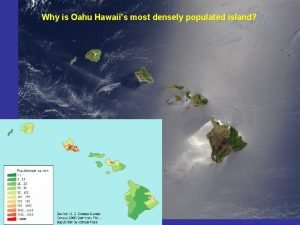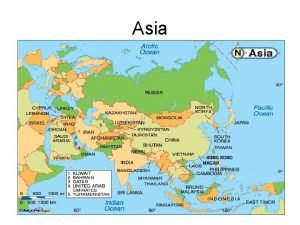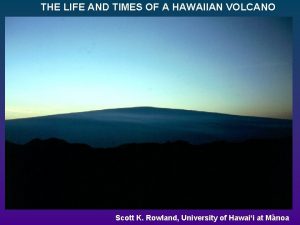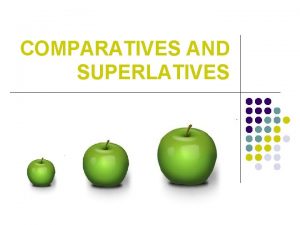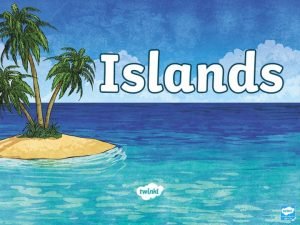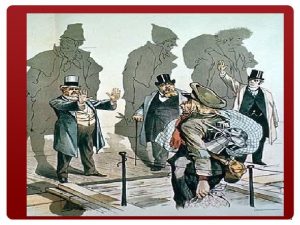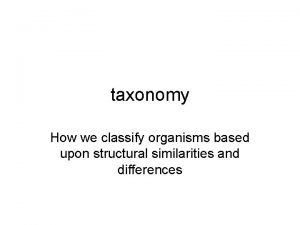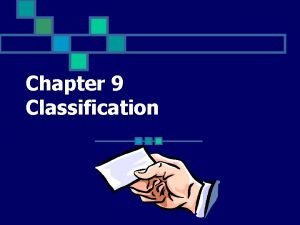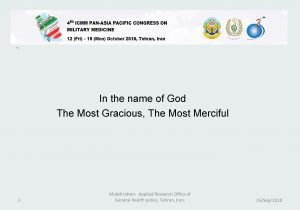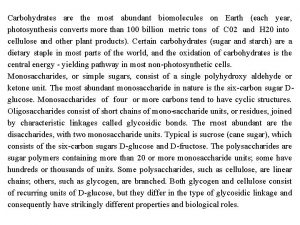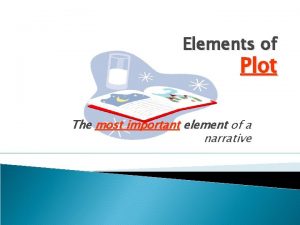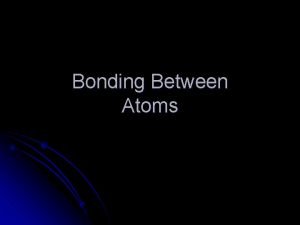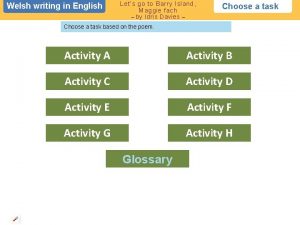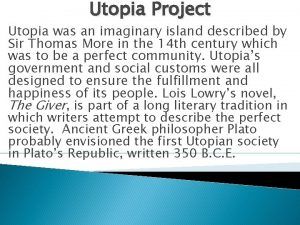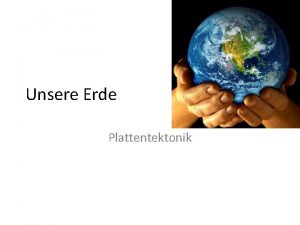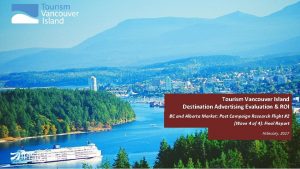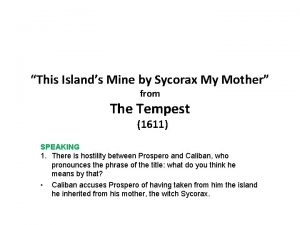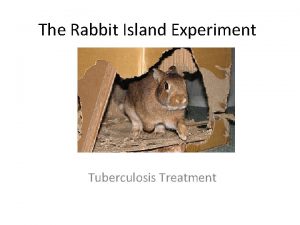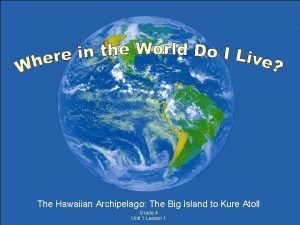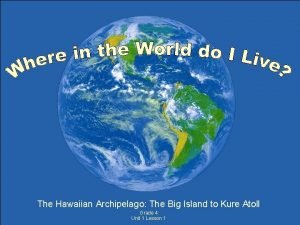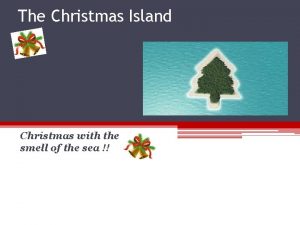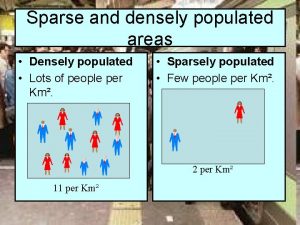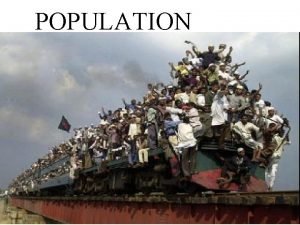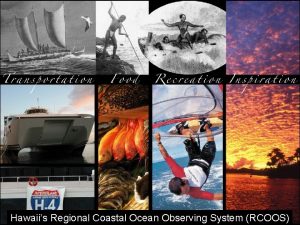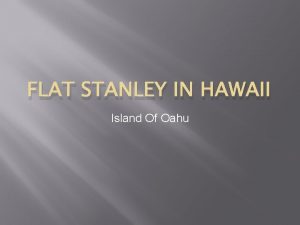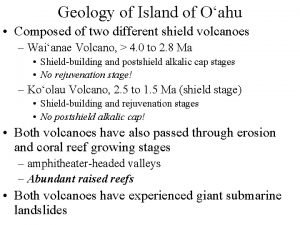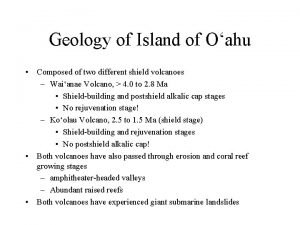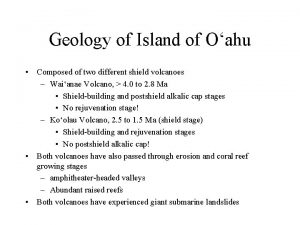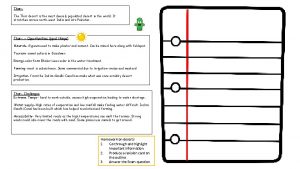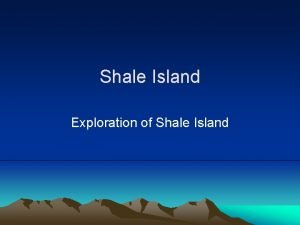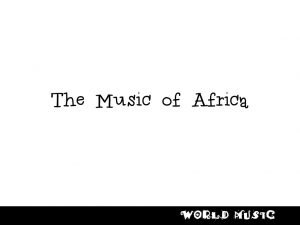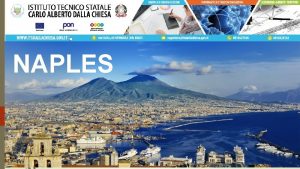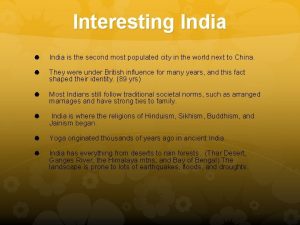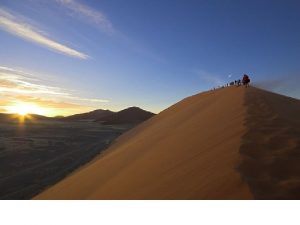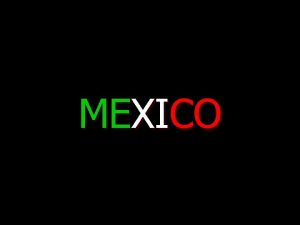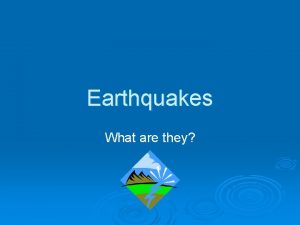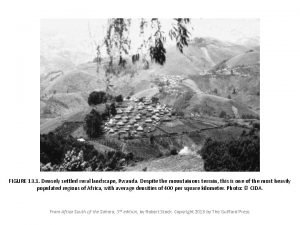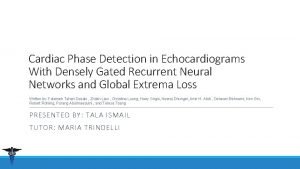Why is Oahu Hawaiis most densely populated island



























































- Slides: 59

Why is Oahu Hawaii’s most densely populated island?


Koolau Volcanics Alluvial saddle Waianae Volcanics

1. 2. 3. 4. 5. 6. 7. 8. Recharge – rainfall, fog drip, irrigation water Porosity vs. permeability Freshwater lens (Ghyben-Herzberg Principle 1: 40) Caprock Brackish transition zone Saltwater zone Dike impounded system Wells A-E

What are the sources of Oahu’s water? up to 400 inches/year as low as 10 inches/year

What are the sources of Oahu’s water?

What are the sources of Oahu’s water? Irrigation Rain Fog Drip

How much water actually stays in the ground?

How much water actually stays in the ground? Oahu RECHARGE = 10 -50% of rainfall, fog drip, irrigation

Where does the groundwater go?

Pahoehoe and Aa flows


Porosity % of the total volume of the rock that contains pore spaces Permeability the ability of a material to transmit fluid Aquifer Permeable rock strata or sediments that transport groundwater

Porosity and permeability of volcanic material good What impedes groundwater flow on Oahu?


Volcanic dikes create impermeable barriers

Limestone Caprock

What impedes groundwater flow on Oahu? 1. Volcanic dikes 2. Limestone caprock

Island aquifers unique: Fresh water floats on salt water Height of groundwater above sea level (water table) Sea level (water table) Freshwater lens Brackish water transition zone Salt water

Ghyben-Herzberg Principle 1 ft 40 ft Height of groundwater above sea level (water table) = 1/40 th Freshwater lens thickness (Sea water 1/40 th more dense than fresh water)

Volcanic dikes and the limestone caprock cause fresh water to pond in the island’s interior

Geology controls aquifer locations

How do we access these aquifers?

How do pumping rates affect aquifers? What is relationship between: 1. Pumping rate 2. Well water level 3. Chloride content (salt intrusion) 4. ? ? ?

Chloride content Well water level Pumping rate Fresh water lens is thinning via saltwater intrusion

Excessive pumping thins fresh water lens Water level, 1966 -2006 Aiea Well Pumping rates 1901 -1980 Halekauwila Well Salt content, 1973 -2006

Oahu’s fresh water lens, the source of our drinking water, is thinning Depth to water table increasing Depth to salt water decreasing water table – top surface of water-saturated zone

What’s happening to Hawaii’s population?

What’s happening to Hawaii’s population? Rate of population growth increasing 9. 3% increase 5. 3% increase (Honolulu 4. 8%) (Honolulu 3. 3%) 2005

Where is growth happening?

Employment

Oahu Population Growth How will the expected population growth affect groundwater resources ? ? ?

1. Growing population 2. Increasing groundwater withdrawal 3. Thinning fresh water lens What else do we have to protect our groundwater from?


Sample contaminants TCE – metal/dry cleaning fluid DBCP – pesticide EDB – pesticide/fumigant TCP – soil fumigant Dieldrin – insecticide Chlordane – insecticide Carbon tetrachloride – propellant/pesticide Atrazine - pesticide Contaminated drinking water wells on Oahu results from 1995 -2005


Pesticides

DBCP (1, 2 -dibromo-3 -chloropropane) Carcinogen Reproductive toxicant Developmental toxicant Endocrine toxicant Gastrointestinal/liver toxicant Neurotoxicant Respiratory toxicant Skin toxicant Top 10% most hazardous compounds Dieldrin Carcinogen Cardiovascular toxicant Endocrine toxicant Gastrointestinal/liver toxicant Immunotoxicant Kidney toxicant Neurotoxicant Reproductive toxicant Respiratory toxicant Top 10% most hazardous compounds

Industrial Solvents: Trichlorethene (TCE) Removes grease from vehicle parts, paint remover Found in Schofield wells in 1985 Carcinogen, cardiovascular toxicant, developmental toxicant, endocrine toxicant, gastrointestinal/liver toxicant, immunotoxicant, kidney toxicant, neurotoxicant, reproductive toxicant, respiratory toxicant, skin toxicant

Drinking water wells serving 25, 000 military and 55, 000 civilians contaminated with TCE.

Hawaii Superfund Sites Contaminants Fumigants: EDB, DBCP, DCP PCBs, volatile organics, semi-volatile organics, metals Metals, organic compounds, petroleum hydrocarbons Industrial solvent: TCE

Pearl Harbor Superfund Site Soil, groundwater, sediment contaminated with metals, organic compounds, petroleum hydrocarbons

Fuel Additives MTBE – fuel efficiency enhancer, possible carcinogen, nervous system effects, liver & kidney damage, etc.

Where is water table on Oahu?

Leaking Underground Storage Tanks

Irritability, excess salivation, labored breathing, tremors, convulsions, deep depression, anemia, leukemia, damage to liver, kidney, lungs, heart, spleen, adrenal glands; cancer, death Chlordane: pesticide Illegal since 1988 Prior to that 3. 6 million lbs/year used in U. S.

Waimanalo (? ) Gulch Landfill Ma'ili 200 acres 15 years Nanakuli B 432 acres 15. 6 years Makaiwa Gulch 338 acres 25 years Ameron Quarry 391 acres 15 years 80 abandoned landfills on Oahu decorating products (paints, stains, varnish, paint thinners), garden products (pesticides, fungicides, herbicides), vehicle products (engine oil, brake fluid, antifreeze, car batteries), household cleaners (bleach, disinfectant, air fresheners), toiletries (cosmetics, old medicines), batteries from watches, radios, mobile phones, etc. may contain heavy metals like mercury, nickel, cadmium


Golfing in paradise… 14% of tourists lots of locals

Oahu Golf Courses 1) Ala Wai Golf Course 2) Barbers Point Golf Course 3) Bayview Golf Links 4) Coral Creek GC 5) New Ewa Beach GC 6) Ewa Villages Golf Course 7) Ford Island Golf Course 8) Hawaii Country Club 9) Hawaii Kai Golf Courses 10) Hawaii Prince Golf Club 11) Hickam Mamala Bay 12) Honolulu Country Club 13) Kahuku Golf Course 14) Kalakaua Golf Course 15) Kaneohe Klipper GC 16) Kapolei Golf Course 17) Ko Olina Golf Club 18) Koolau Golf Course 19) Leileihua Golf Course 20) Luanna Hills 21) Makaha Valley CC 22) Makaha Resort GC 23) Mid Pacific CC 24) Mililani Golf Club 25) Moanalua Golf Club 26) Navy-Marine Golf Course 27) Oahu Country Club 28) Olomana Golf Links 29) Pali Golf Course 30) Pearl Country Club 31) Ted Makalena Golf Course 32) Turtle Bay Resort Golf Club 33) Waialae Country Club 34) Waikele Golf Club 35) Walter Nagorski Golf Course 36) West Loch Golf Course Average 1000 lbs chemical pesticides per year …also fertilizers, herbicides…


Non-point source pollution

Now that the pollution is there, what can we do?


Now that the pollution is there, what can we do? 1. Stop polluting

Now that the pollution is there, what can we do? 1. Stop polluting ($) Military $5. 6 billion in Hawaii in 2005; 125, 000 jobs Hawaii pineapple industry worth $135 million annually Pest control, petroleum industry, golfing…$$$ 2. ?

Now that the pollution is there, what can we do? 1. Stop polluting ($) Military $5. 6 billion in Hawaii in 2005; 125, 000 jobs Hawaii pineapple industry worth $135 million annually Pest control, petroleum industry, golfing…$$$ 2. Monitor water quality ($) Hawaii Department of Health Environmental Monitoring Budget FY 2007 - $243, 953, 098 ($201/person/year) 3. ?

Now that the pollution is there, what can we do? 1. Stop polluting ($) Military $5. 6 billion in Hawaii in 2005; 125, 000 jobs Hawaii pineapple industry worth $135 million annually Pest control, petroleum industry, golfing…$$$ 2. Monitor water quality ($) Hawaii Department of Health Environmental Monitoring Budget FY 2007 - $243, 953, 098 ($201/person/year) 3. Install filtration systems ($) $895 -$8, 000+ / household

Groundwater contaminants REGULATED Alpha emitters Beta/photon emitters Radium 228 radioactive particles (naturally-occurring) Nitrate fertilizer Barium metal – drilling mud Chromium metal – making steel, dyes & pigments, chrome plating, leather tanning, wood preserving 1, 2, 3 -Trichloropropane industrial solvent, paint and varnish remover, cleaning and degreasing agent Fluoride dental health additive UNREGULATED Sulfate mineral (naturally-occurring) Dieldrin pesticide
 Why is oahu the most populated island
Why is oahu the most populated island Tigris and euphrates river
Tigris and euphrates river A'a hawaiian
A'a hawaiian Why why why why
Why why why why Easygoing comparative hali
Easygoing comparative hali Populated country in the world
Populated country in the world A or an island
A or an island Ellis island and angel island differences
Ellis island and angel island differences Ellis island and angel island venn diagram
Ellis island and angel island venn diagram Island of the blue dolphins island map
Island of the blue dolphins island map Dont ask why why why
Dont ask why why why Death swamp the most dangerous game
Death swamp the most dangerous game Ship trap island map from the most dangerous game
Ship trap island map from the most dangerous game Most general to most specific classification
Most general to most specific classification Most general to most specific classification
Most general to most specific classification In the name of allah, the most gracious, the most merciful
In the name of allah, the most gracious, the most merciful The most
The most Ponceau pronunciation
Ponceau pronunciation In the name of allah the most beneficent the most merciful
In the name of allah the most beneficent the most merciful Name of organisms
Name of organisms The arrangement chapter 9
The arrangement chapter 9 In the name of god, most gracious, most merciful prayer
In the name of god, most gracious, most merciful prayer In the name of allah the most gracious the most merciful
In the name of allah the most gracious the most merciful In the name of allah, the beneficent, the merciful
In the name of allah, the beneficent, the merciful In the name of god most gracious most merciful
In the name of god most gracious most merciful Aqeedah meaning
Aqeedah meaning In the name of god the most gracious the most merciful
In the name of god the most gracious the most merciful Most beneficent
Most beneficent What profession do you prefer
What profession do you prefer Curriculum guide for driver education in virginia module 5
Curriculum guide for driver education in virginia module 5 Which is the most abundant biomolecule on earth
Which is the most abundant biomolecule on earth Element of a plot
Element of a plot Why do atoms form bonds
Why do atoms form bonds Paramecium photosynthesis
Paramecium photosynthesis Why-why analysis
Why-why analysis Wh tongue twister
Wh tongue twister Does the table represent a function why or why not
Does the table represent a function why or why not Does this table represent a function why or why not
Does this table represent a function why or why not Why or why not
Why or why not Contoh laporan root cause analysis
Contoh laporan root cause analysis Let's go to barry island poem words
Let's go to barry island poem words Coconut tree and its uses
Coconut tree and its uses Deasybib
Deasybib Island plattentektonik
Island plattentektonik Stoichiometry island diagram
Stoichiometry island diagram Uninhabited us territories
Uninhabited us territories Easter island apes
Easter island apes Advertising vancouver island
Advertising vancouver island Barn- och elevombudet
Barn- och elevombudet Mother of caliban
Mother of caliban Krista
Krista The rabbit island experiment
The rabbit island experiment Odysseus background
Odysseus background The lost colony of roanoke
The lost colony of roanoke Lisianski island
Lisianski island Necker island hawaii
Necker island hawaii Map of west and east egg
Map of west and east egg Ps 38 staten island
Ps 38 staten island Christmas island religion
Christmas island religion Study island sound
Study island sound
